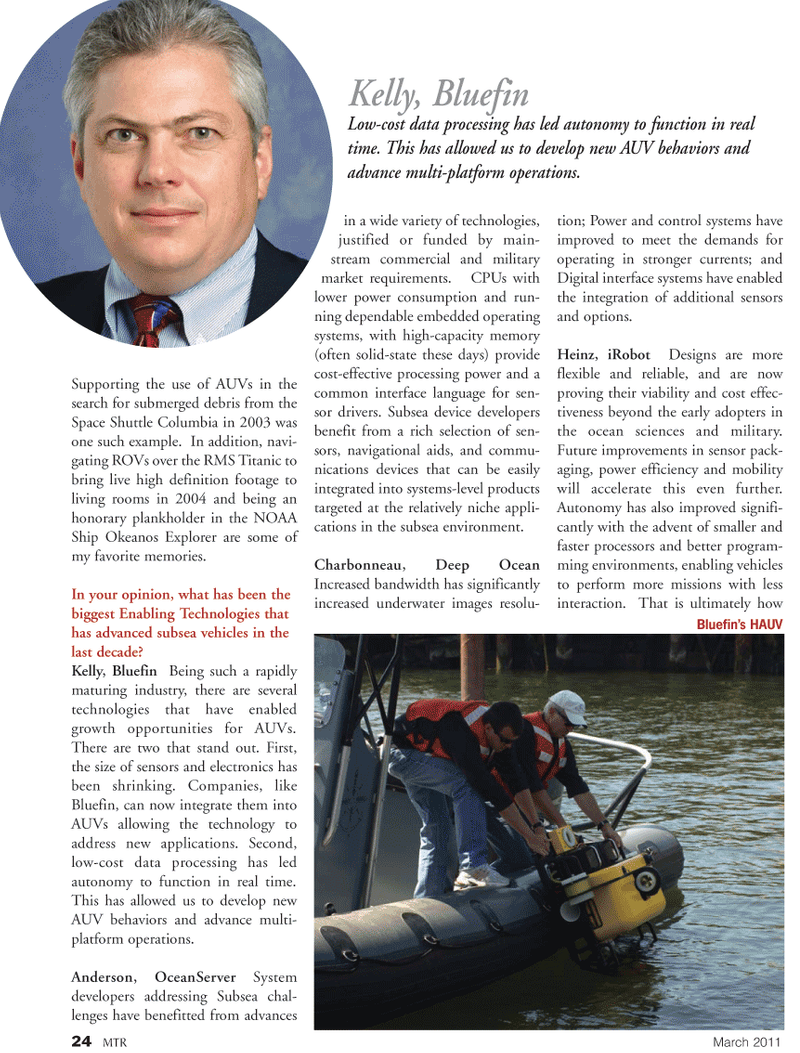
Page 24: of Marine Technology Magazine (March 2011)
Subsea Vehicles: AUV, ROV, UUV Annual
Read this page in Pdf, Flash or Html5 edition of March 2011 Marine Technology Magazine
Supporting the use of AUVs in the search for submerged debris from the
Space Shuttle Columbia in 2003 was one such example. In addition, navi- gating ROVs over the RMS Titanic to bring live high definition footage to living rooms in 2004 and being an honorary plankholder in the NOAA
Ship Okeanos Explorer are some of my favorite memories.
In your opinion, what has been the biggest Enabling Technologies that has advanced subsea vehicles in the last decade?
Kelly, Bluefin Being such a rapidly maturing industry, there are several technologies that have enabled growth opportunities for AUVs.
There are two that stand out. First, the size of sensors and electronics has been shrinking. Companies, like
Bluefin, can now integrate them into
AUVs allowing the technology to address new applications. Second, low-cost data processing has led autonomy to function in real time.
This has allowed us to develop new
AUV behaviors and advance multi- platform operations.
Anderson, OceanServer System developers addressing Subsea chal- lenges have benefitted from advances in a wide variety of technologies, justified or funded by main- stream commercial and military market requirements. CPUs with lower power consumption and run- ning dependable embedded operating systems, with high-capacity memory (often solid-state these days) provide cost-effective processing power and a common interface language for sen- sor drivers. Subsea device developers benefit from a rich selection of sen- sors, navigational aids, and commu- nications devices that can be easily integrated into systems-level products targeted at the relatively niche appli- cations in the subsea environment.
Charbonneau, Deep Ocean
Increased bandwidth has significantly increased underwater images resolu- tion; Power and control systems have improved to meet the demands for operating in stronger currents; and
Digital interface systems have enabled the integration of additional sensors and options.
Heinz, iRobot Designs are more flexible and reliable, and are now proving their viability and cost effec- tiveness beyond the early adopters in the ocean sciences and military.
Future improvements in sensor pack- aging, power efficiency and mobility will accelerate this even further.
Autonomy has also improved signifi- cantly with the advent of smaller and faster processors and better program- ming environments, enabling vehicles to perform more missions with less interaction. That is ultimately how
Kelly, Bluefin
Low-cost data processing has led autonomy to function in real time. This has allowed us to develop new AUV behaviors and advance multi-platform operations.
Bluefin’s HAUV 24 MTR March 2011

 23
23

 25
25
